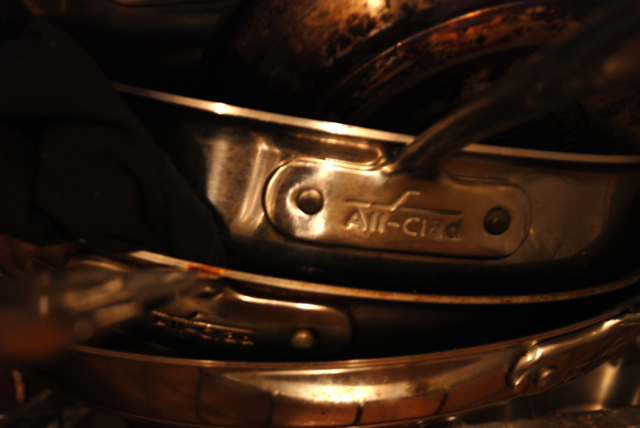It’s been too long, I know. Based on all of y’all who end up on my site after searching for “silky (or any variant of spelling) chicken,” I figured it was time at long last to cook the darn thing.
As you will recall, I bought some chickens from bo bo chicken farm, based out of upstate New York. They are not organic, as mentioned, but raised locally, so that’s still better than nothing. I roasted that regular young chicken ’till he was GB&D (golden brown and delicious), to steal from Ming Tsai (what’s that guy up to, anyway?).
Now, it was time for his silkier cousin to get cooked up. There are a lot of choices for chicken, but I knew that black chicken would be a special case. When I was sold the chicken, they tried to push some baggie of sticks and stuff that was the base for a soup. Silky chicken tonic soup, they call it (here). At the time, I wanted to roast the thing, just to see what it tastes like by itself. But when I pulled the little guy out of the freezer, I didn’t think that was such a great idea.
There were other braising recipes, like one from Patricia Yeo, but again, the ingredient list consisted of too many items that I would have to travel to get and/or require some sort of special translation. I decided to make something up. The only thing I knew I wanted to include was star anise. That was pretty much my only requirement.
So I pulled a few items out of the spice cabinet.
I was making this thing up, so I figured I could use as many ingredients as I wanted. The basics were: star anise, cinnamon, lemongrass, soy sauce, sesame oil, hoisin sauce, brown sugar, juniper berries, pink peppercorns, red wine, vegetable oil, rice wine vinegar, and these wasabi sesame seeds that my stepmom gave to me (re-gift from her bro). I also had diced carrots and onions. I wanted it all in there.
I started out by butchering the chicken. I realized one thing about the silky chicken: not a lot of meat. As in, REALLY not a lot of meat. Practically none. It’s just a mass of grey flesh and grey bones and purple skin. Maybe the one I got in particular was particularly devoid of breast meat, but there was nothin. Tiny little breasts and decently sized thighs, although nothing to write home about. I also couldn’t figure out where everything was, it was all just a little bit different from a normal bird.
Anyway, I probably mutilated the thing, but it’s all good. This was all in the name of science.
After that, I went about my way with pretty standard braising steps. Browned the chicken.
Now, if you will notice, when the breast is cooked, it still turns white. This is because it has less myoglobin, which apparently is what makes meat dark or light when cooked. More myoglobin= darker when cooked (also means that it was a slow-twitch muscle, like legs, shoulders, etc). Anyway, this was kind of disappointing, since I wanted the flesh to be grey, even when cooked. Also, in case you were wondering, the blood is still red, too. Can you say “disappointment?”
After browning it up, I took the chicken out and sautéed the veg in the fat (there wasn’t much) and then threw all of that stuff into the pot after deglazing with a combination of rice wine vinegar and red wine. Everybody went into the pool. Then, I cooked it down for about 45 minutes or so. That was it! Roasted some fingerlings on the side, and cooked up some baby bok choi in butter and sesame oil, and Bob’s your uncle!
As you can see, it looks kinda like chicken. And, sorry to disappoint, but it also tastes… like chicken. It really didn’t taste much different than the other Bo Bo chicken. Which isn’t a bad thing, but I was hoping it would taste like, well, something else. Anyway, enjoy, and try to get one if you can. Buy local!
Speaking of local, I got some Milk Thistle farm chocolate milk. Quite tasty. Ronny has competition.
Also speaking of local again, got some R-brook Vanilla ice cream. And I put chestnut purée on it. That was delightlful. See if you can get some of that stuff, too. The purée is from France, but I’ll allow it.






